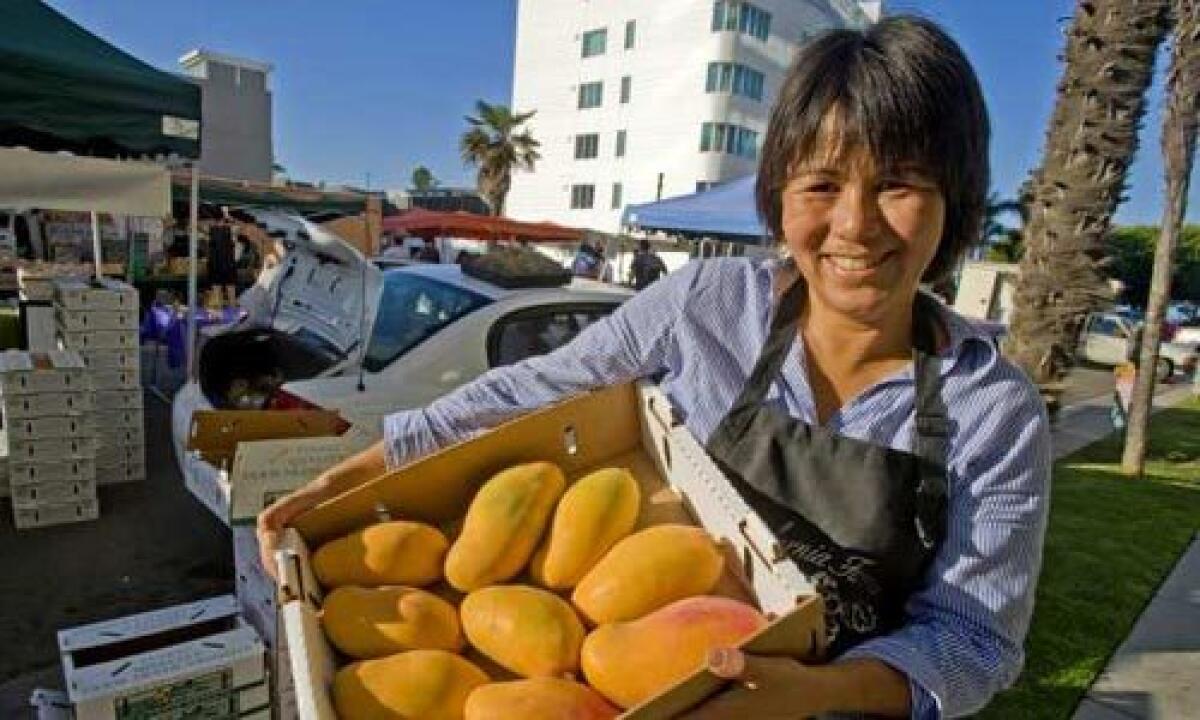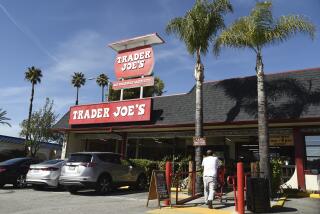Ripe time for mangoes from Wong Farms

Among the most eagerly awaited treats sold at farmers markets are the luscious mangoes grown by Wong Farms in Mecca, just north of the Salton Sea. When Deborah Wong Chamberlain started selling her crop last Wednesday at the Santa Monica farmers market, most of her truckload was already spoken for by customers who started calling her weeks ago, even though her mangoes are far more expensive, at $3.49 a pound, than the imported ones sold at supermarkets. Hers, however, are of matchless flavor and texture.
Most mangoes sold in the United States come from Mexico and South America and are treated with hot water to kill insect pests, which also extinguishes their aroma. Locally grown fruit doesn’t require this treatment, and ripe specimens will perfume a room with their rich, floral fragrance.
Store-bought mangoes also can disappoint because the leading commercial variety, Tommy Atkins, grown for its red blush and high yields, has a fibrous texture and mediocre flavor. Most of the mangoes grown by Wong Farms, in contrast, are of the Keitt variety, which originated in Florida in 1939; its skin is dull green, but its bright orange flesh is delightfully smooth and very sweet. The farm also has 10 trees of Valencia Pride, a home-garden variety with a kidney shape, deep yellow skin (sometimes with a wisp of pink blush) and even more intense flavor and aroma than Keitt.
Post-harvest textbooks say that mangoes should always be picked like avocados, when mature but not soft, and then ripened off the tree, to ensure uniform texture. That’s necessary for commercial shipments, but the Wong fruits range in maturity from firm to squishy ripe (the latter usually sold as seconds, for smoothies or baking). The tree-ripened fruits are sweetest and most aromatic, although they can have gelatinous soft spots, typically at the nose (opposite the stem); for most buyers, fruits that are just short of fully ripe may be the best bet.
Wong Farms has just 100 mango-bearing trees, about one acre, but has planted another 100 trees that will start bearing in several years. To order mangoes for next Wednesday’s market, call (760) 265-9167, or e-mail wongfarms@aol.com.
There are also two commercial plantings in the Coachella Valley, with about 280 acres of Keitt; the fruit will be available from next week through October at local supermarkets including Whole Foods, Vons, Bristol Farms, and Wal-Mart.
::
Just up the road from the Wong planting is Bautista Family Organic Date Ranch, which has just started bringing its new crop to market. Last week the farm had yellow Barhi dates in the firm, crunchy, khalal stage; these can be eaten fresh or left on a warm counter to turn soft and translucent amber-brown, the rutab stage. Commercially sold dates are usually matured one step further, to the firmer, drier tamar stage, at which point they store and ship best. But consumers in North Africa and the Middle East, where dates are native, greatly prize the softer rutab fruits, which are only available in best condition for a month or two. Freshly ripened rutab Barhi dates are particularly soft and scrumptious; eating one is like biting into a caramel cloud.
Most of the date varieties other than Barhi sold in the United States are too astringent to eat firm, but all are as exquisite as they are rare in the rutab stage. Bautista currently is offering rutab Medjool, Khadrawy and honey dates, with more varieties to come in the next few weeks. The farm sells at many markets, including Beverly Hills (Sunday); Culver City (Tuesday); Hollywood (Sunday); Irvine (Saturday); Long Beach (Sunday) Santa Monica (Second and Arizona, Wednesday and Saturday; organic Main Street, Saturday; Virginia Park, Sunday); and Torrance (Tuesday and Saturday).
::
Stone fruit varieties turn over every 10 or 20 years and are often sold anonymously, but the O’Henry peach stands out, both for consumer recognition and quality. Introduced in 1968 by Grant Merrill (1899-1973), a private breeder in Red Bluff, it is large, red, firm, round and very productive, all of which endeared it to farmers. It also has meaty, deep yellow-orange flesh, tinged red next to the pit, with rich flavor -- not the absolute best quality but very good for a commercial variety.
In the 1980s and 1990s, O’Henry was the dominant late-season peach grown in California, and as recently as 2005, it led all varieties in shipments. As plantings grew older and breeders released newer, bigger, redder varieties, its importance has declined. It is still widely available at farmers markets, from stands including Balderama, Burkart, Honey Crisp, Regier, Rieger, and Scott. Enjoy it now, before it becomes an heirloom.
More to Read
Eat your way across L.A.
Get our weekly Tasting Notes newsletter for reviews, news and more.
You may occasionally receive promotional content from the Los Angeles Times.






